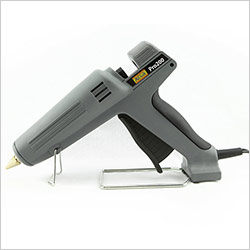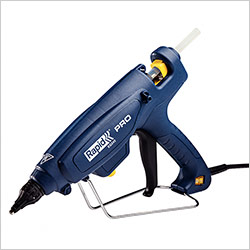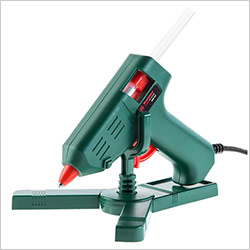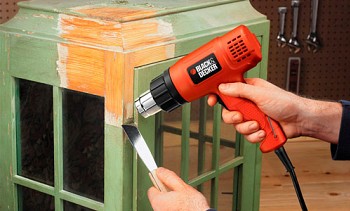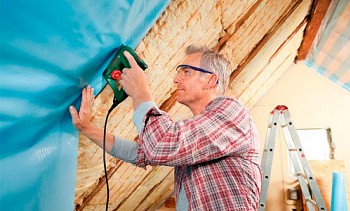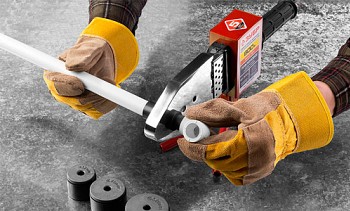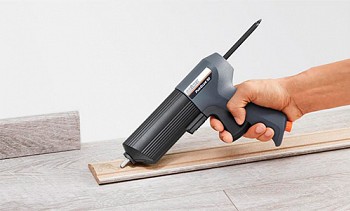How to choose a hot glue gun - tips and tricks
Despite the simplicity of this device, if you decide how to choose a glue gun, you will have to face the need to determine a sufficiently large number of characteristics, which it is desirable to pay attention to. At a minimum, this is the power of the device, which determines with which components it can work and its performance. If you use the gun for professional purposes, the type of food, which nozzles are included in the kit, the indicator of the readiness of the glue, how well the stand is made, and other equally important points will be of importance.
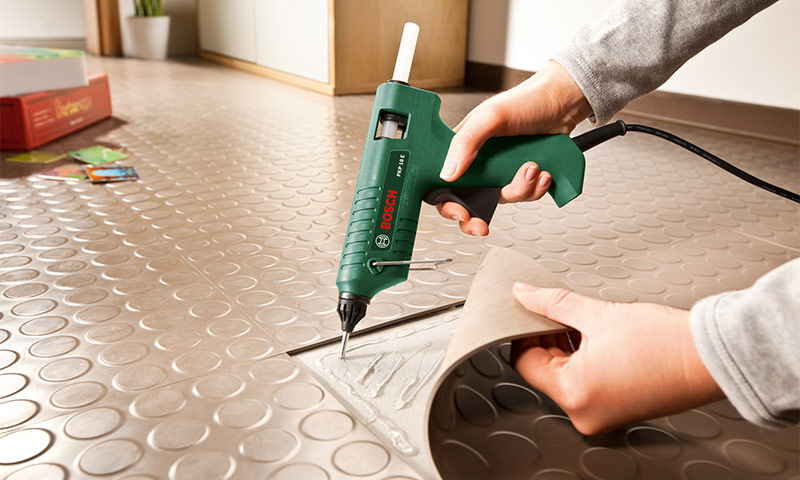
Content:
How to use a glue gun
The prototype of modern glue guns was invented by Harry Green, who at one time set out to make a tool for quickly gluing furniture parts. His device was rather bulky, he used liquid glue to work, but it was the application technology that made it possible to get a neat and even seam with great mechanical strength and elasticity.
When it became possible to use solid glue sticks and the thermal gun became quite compact, it became very widespread. It is much easier to list cases in which it cannot be used - this is the fastening of parts that heat up during operation and can soften the adhesive joint. Also, the adhesive does not stick well on concrete, plaster and some types of polyethylene - since the latter are sensitive to heat, then you need some skill to work with them.
Otherwise, the use of a thermogun is practically unlimited: furniture makers were the first to evaluate its capabilities, builders glue them communication details, and for model designers, radio amateurs, florists and designers, it generally became a real find. In addition to almost instant bonding of parts, using a thermal gun you can get polyurethane figures or patterns, create paintings or make prints on postcards or invitations.
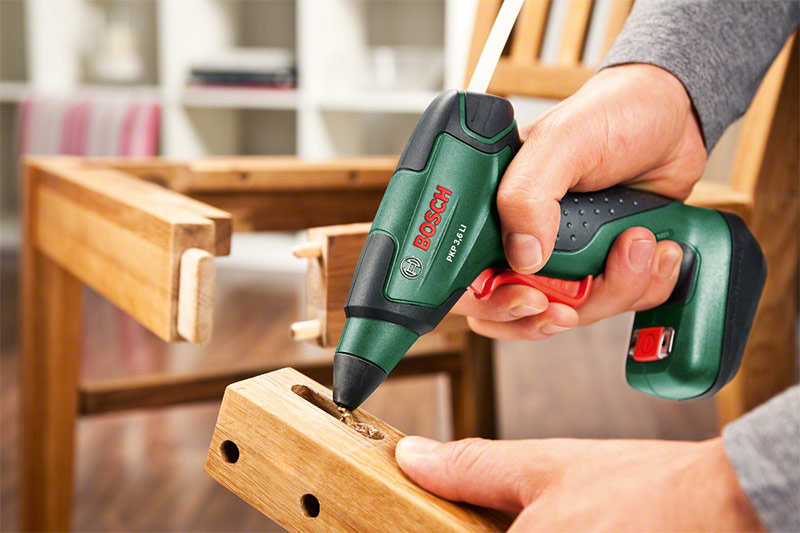
As a result, a thermogun is essentially the same universal glue, but without a pungent odor and capable of completely hardening within 1-3 minutes by gluing wood, paper, cardboard, leather, fabrics, plastic, rubber, metals, ceramic parts in various combinations. Also, do not forget about the basic rule for the use of any glue - the surfaces must be cleaned and degreased before use.
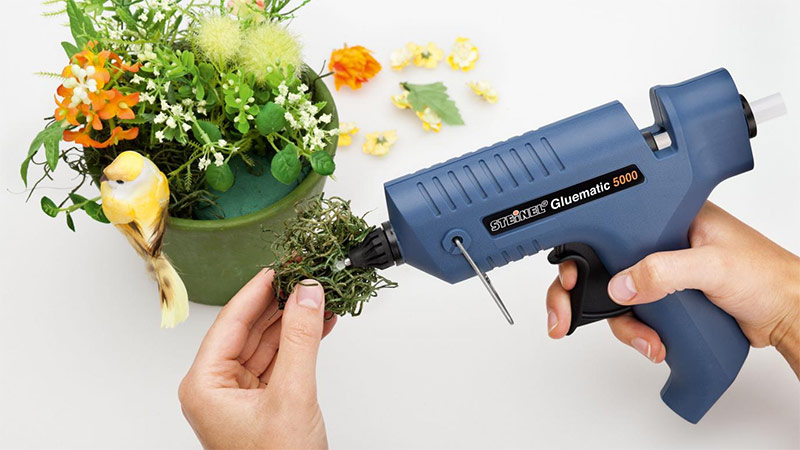
The device and principle of operation of the hot glue gun
The simpler the design of a device, the more reliable it is. Thermoguns fully comply with this rule - they have a minimum of components inside, which are highly reliable and, when used correctly, are as much as possible protected from possible breakdowns.
The shape of a hot gun fully justifies its name - it has a handle for which it is held during operation and a barrel in which the main elements of the device are located.
In the place where the trigger is located on a conventional gun, in the thermal gun there is a receiving hole for the glue sticks. When they are inserted into the casing, they then go further through the coupling into the melting chamber, to which the heating element (TEN) is attached.The part of the rod falling here melts to a fluid state, and if the solid part is further fed into the chamber, then excessive pressure is created, which pushes the hot molten glue out through the nozzle, which is attached to the “barrel” of the thermal gun.
Structurally, the thermal gun consists of the following elements:
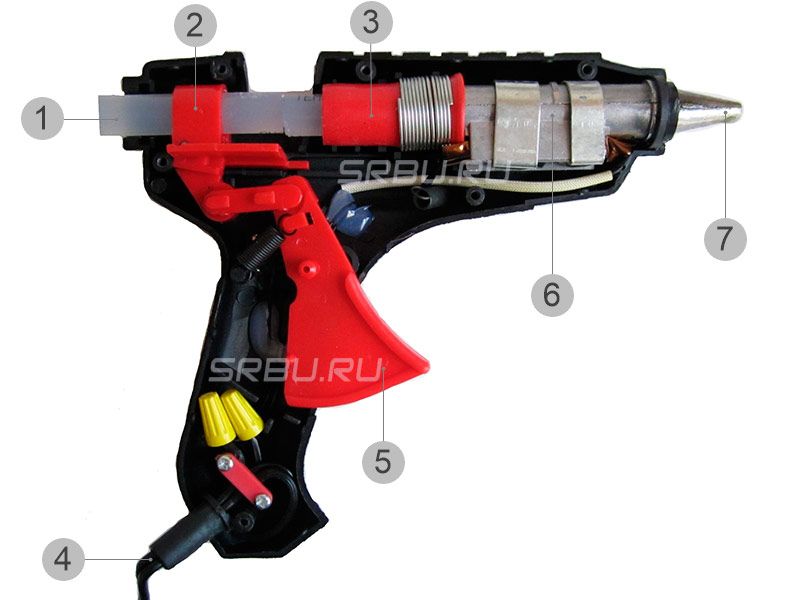
1. Glue stick.
2. Feeder.
3. Guide clutch.
4. Power cord.
5. Trigger.
6. Heating chamber.
7. Nozzle.
Housing
It performs two functions at once: it holds all the parts of the gun together and in itself is a stand to leave the gun in the right position until it is used. The fact is that when the adhesive mass in the heating chamber is already melted, it is undesirable to hold the gun upward for a long time. It is also strongly not recommended to lay it on its side when it is turned on, as this can cause significant overheating of the case and the failure of the thermal gun.
In order to leave the gun in the desired position, a special platform is usually made on the bottom of its handle, on which it is placed, and a hinged stand made of plastic or steel wire is attached to the front of the barrel. Thus, the case has three support points for reliable fixation of the device in the desired position (one in the handle and two on the stand).
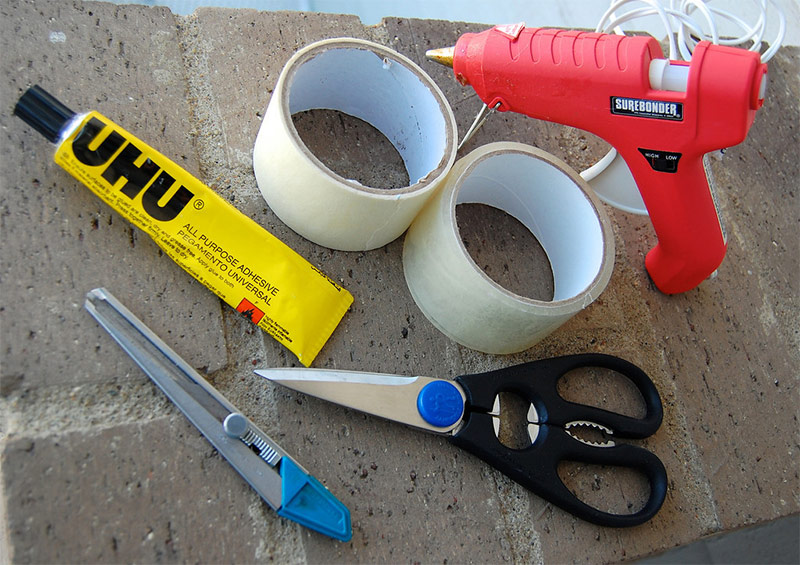
Since there are parts inside the device that heat up significantly during operation, the case is made of hard plastic with low thermal conductivity. Also, such materials are lightweight, so the final mass of the device rarely exceeds 300 grams.
The handle of a thermal gun is usually not distinguished by anything special - often there is nothing besides the power wire and the trigger inside it. For the convenience of using a thermal gun, anti-slip rubber pads can be fixed on it from the outside.
Feeder
The so-called annular pusher is in direct contact with the glue stick - it is a plastic / metal smooth (or tooth-hooking ring) ring. When the lever force is transmitted to it, the ring rotates somewhat in the vertical plane, due to which the rod is captured and stretches after it towards the heating chamber.
The force is created by the trigger of a carousel or slider type (moves around its axis or along the barrel), and is transmitted to the ring by means of a lever. Often, the last detail is the weakest point in the mechanics of the device, because inexperienced users can press the trigger too hard, trying to “squeeze” more glue.
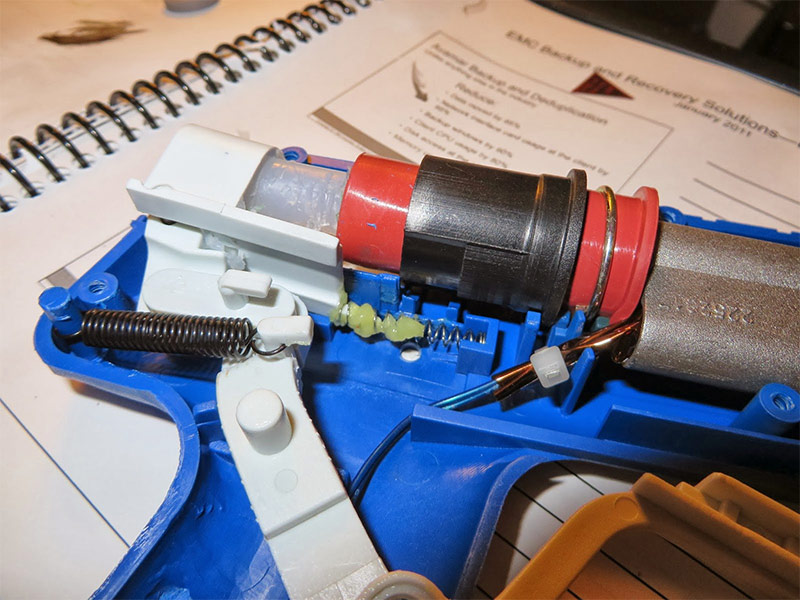
When deciding which glue gun to choose, be sure to consider that the ring itself may be a problem part if it is made to a specific rod size. As a result, even with small diameter errors, the rod will hardly pass through the ring or slip through it.
Guide clutch
In fact, it’s just a rubber tube, one end of which is put on the heating chamber, and an adhesive rod is wound in the other.
This part has two main functions:
- It embraces an even harder rod, which prevents molten mass from flowing out of the heat chamber into the gun body.
- It is a kind of temperature bridge - if the glue stick were inserted directly into the heat chamber, then due to heat transfer it would melt even before it during downtime.
Despite the fact that the guide sleeve is made of heat-resistant rubber, it should be remembered that this is one of the weakest parts of the gun. If the whole mechanism is even a little overheated, then the coupling can easily be damaged by trying to turn the rod or just pull it in the opposite direction.
If different rods are used, to replace them, it is better to cut off the part that has already entered the sleeve, insert a new rod, and squeeze out the remains of the previous one through the nozzle in the usual way.
Heating chamber
In fact, it is a metal tube on which a heating element is fixed.In different devices, various variations of this unit are used, for example, several heaters are installed that heat the rod not in one place, but gradually from the beginning of the tube to the outlet.
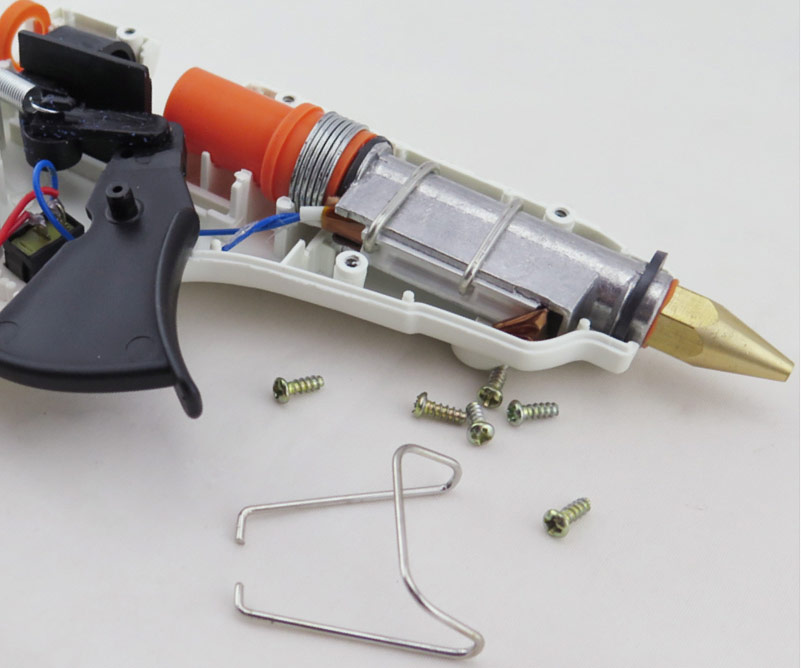
The power and performance of the entire thermal gun depends on the heating unit. The larger the volume of the heating chamber, the wider the section of the rod that will warm up, and how quickly this will happen - depends on the power of the heater.
Despite the fact that this is the main working part, it is often the most reliable - with proper operation of the device, there is practically no damage to the heater.
Nozzle (nozzle or nozzle)
The main task of this part is to give the desired shape the adhesive mass coming out of the nozzle and its dosage. Depending on the class and cost of the thermal gun, a direct-flow nozzle or with a valve is used. In the first case, it simply provides the necessary thickness of the outgoing adhesive mass, and its dosage is carried out by the feeding mechanism. The disadvantage of this solution is some loss of glue, since when a certain level of fluidity is reached, it freely flows out.
If there is a nozzle with a valve, then a spring-loaded ball is placed inside it, which blocks the outlet of the adhesive mass, until the trigger creates excessive pressure to unlock the channel. As an additional protective measure, the ball never blocks the outlet completely - if the working chamber overheats and the glue in it becomes too fluid, then its excess is also brought out.
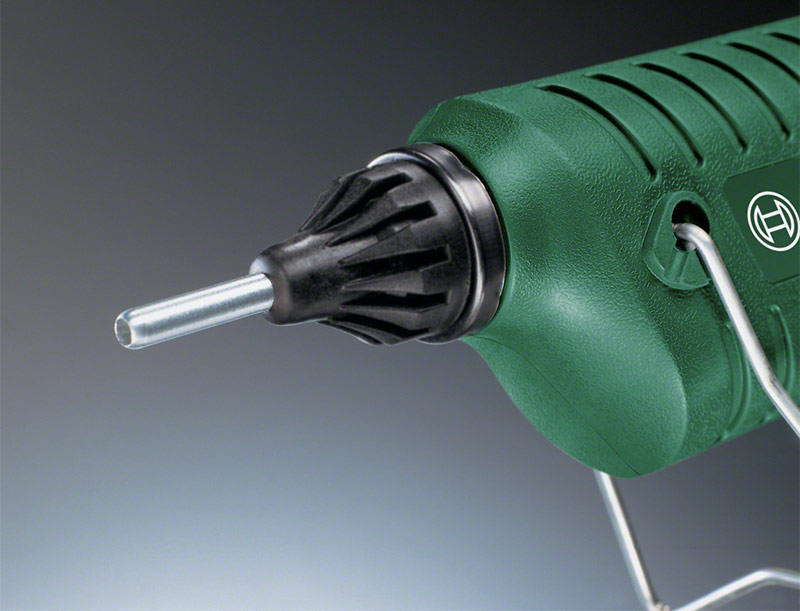
As a result, when working with a glue gun, you always need to use a stand, on which excess glue will be collected.
Like the heating chamber, the nozzle is made of metal, but is closed by a protective casing on the outside, which prevents possible burns when carelessly touched. If the nozzle is removable, then the thermal gun is equipped with several such nozzles - this allows you to get an adhesive layer of various shapes. Also in the kit there may be additional standard nozzles, but with an elongated nozzle, which simplifies access to hard to reach places.
Mounting to the gun is carried out by a threaded connection, but the old nozzle can only be unscrewed when the heat chamber has already been warmed up - otherwise the glue that has hardened inside will prevent replacing the part.
Technical characteristics that must be considered when choosing a thermal gun
Far from always, “more” means “better” - this fully applies to thermoguns, because such devices are made to perform various tasks, and therefore can be equipped with functions or have characteristics that, if not correctly selected, will remain unclaimed.
Power and heating rate
By the power of a thermal gun is meant the number of watts per hour that the heating device consumes. It is easy to assume that the higher this characteristic, the less time it will take to melt the glue, but it will also be useful to take into account concepts such as profitability and productivity. For example, a combination of a capacious heating chamber and a weaker heater, which can still provide the desired temperature, will consume less electricity than a powerful heater and a small chamber. In addition, the risk of overheating is reduced, which affects the overall life of the device.
For comparison, professional devices consume about 300 watts per hour, but they are designed for rods with a diameter of up to 45 mm. For work with rods of 7-11 mm, heating elements with a power of 30-150 W / h are used.
It may happen that the device’s power is insufficient - then when the current supply of glue is used up, you will have to wait until a new one melts in the chamber.
Some manufacturers went further and supplied the heating chamber with a temperature sensor, which allows for automatic power control.When the camera is cold (before turning it on), the consumption will be maximum - about 200 watts, and when the optimum temperature is reached, the standard or economy mode is activated, in which the heater needs 15-40 watts.
As a result - if it is not critical for 3 or 5 minutes, the thermal gun heats up to working condition, then chasing a more powerful device does not make much sense. If you are supposed to work with him for many hours, then when deciding how to choose an adhesive thermal gun, you need to pay attention not to power, but to its performance. If for some reason the heating speed is important, then it is better to purchase a device with a power regulator.
Melt temperature
Since the thermogun is used to work with a large number of materials, it should be borne in mind that all of them transfer heat differently and for some, glue with a lower (if possible) melting point is needed. For example, for paper and many types of fabrics, pistols operating at a temperature of about 105 degrees are used. Also manufactured devices that can operate in several modes, usually 105 165 and 200 degrees.
It is clear that the higher the temperature in the chamber, the less the durability of the device itself. It should also be borne in mind that the vast majority of glue sticks melt already at 105 degrees, and the heat chamber, which produces a high temperature, simply accelerates the entire process.
As a result, if the thermogun is not purchased for professional use, it makes no sense to choose models with a maximum temperature. The golden mean for this characteristic are values of 165-170 degrees. If you choose a professional device, you should pay attention to models with a temperature regulator, which can be manual or automatic - control is performed by a microcircuit based on data from sensors.
Thermal Gun Performance
This characteristic is also called the speed of the gun, although it is more correct to speak precisely about its performance. This is one of the main values that it is recommended to pay attention to when choosing a thermogun - it shows the amount of glue that can be squeezed out of the nozzle in a certain time. For different devices, this value will vary from 5 to 30 grams per minute and usually it is indicated in the passport of the device.
In parallel with the performance of the gun, you need to pay attention to such a parameter as the adhesive fluidity time, especially if you have to work with large areas of glued materials. Otherwise, the glue at the beginning of the seam may harden before it is applied at the end.
Accordingly, it is precisely the performance of the device that is divided into professional and domestic, because if the thermal gun is used for small crafts, this parameter will not matter.
Type of power supply
If most electrical devices can work from a network or autonomously, then thermal guns in this regard can boast even three modifications:
1. Off network. The most common standard design with a power cord.
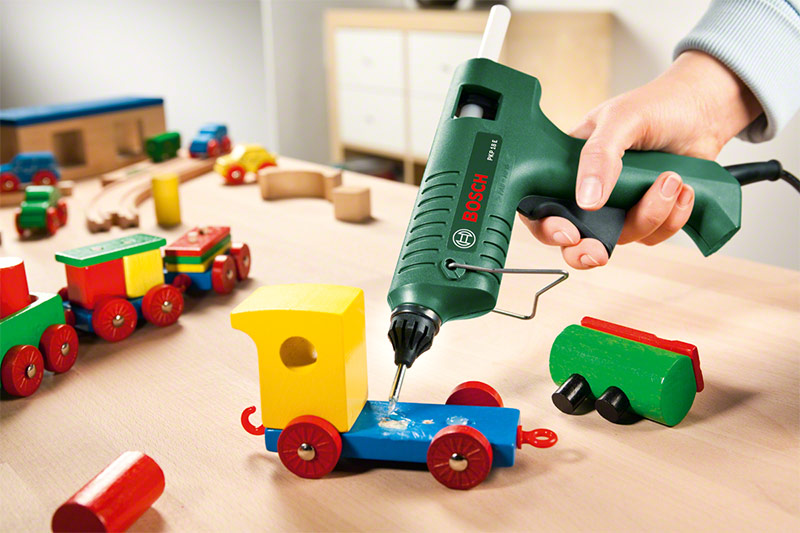
2. From battery. Such devices allow you to work autonomously from 45 minutes to 2 hours. At the same time, the characteristics of thermoguns are quite good - they can warm up a rod with a diameter of 7 millimeters to almost 200 degrees in 15 seconds.
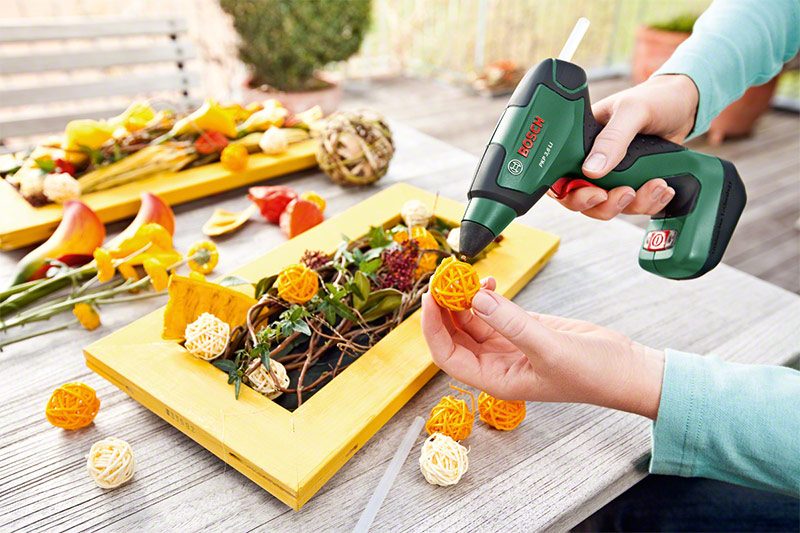
3. Semi-autonomous. A device with this design has a detachable power cord, after which the temperature in the chamber is maintained for 10-15 minutes.
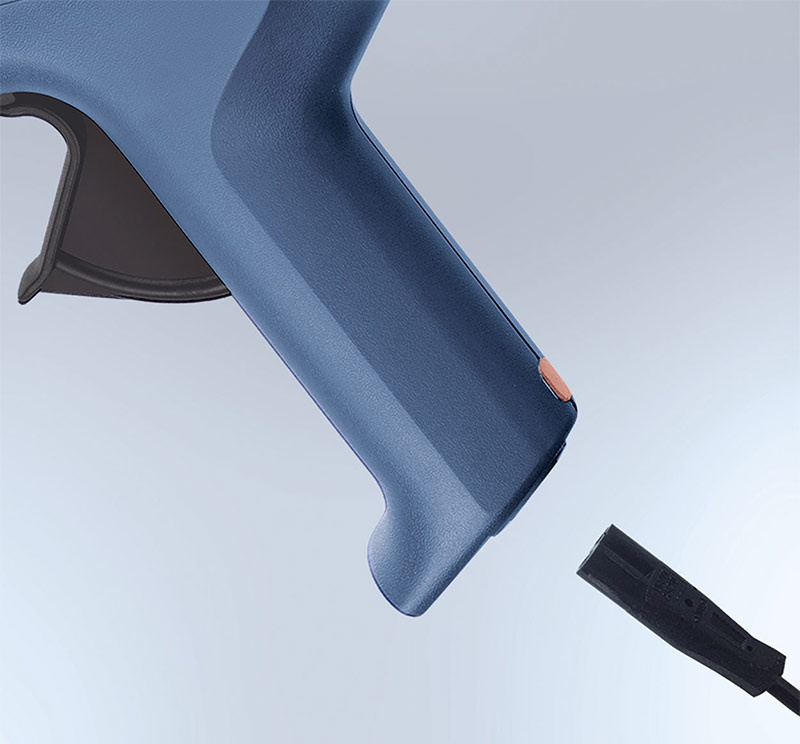
Wireless devices are also common, which is used in conjunction with a docking station - while the gun is in it, the heating chamber warms up. An additional plus of the docking stations is that they have a container for collecting glue that is dripping a little from the nozzle.
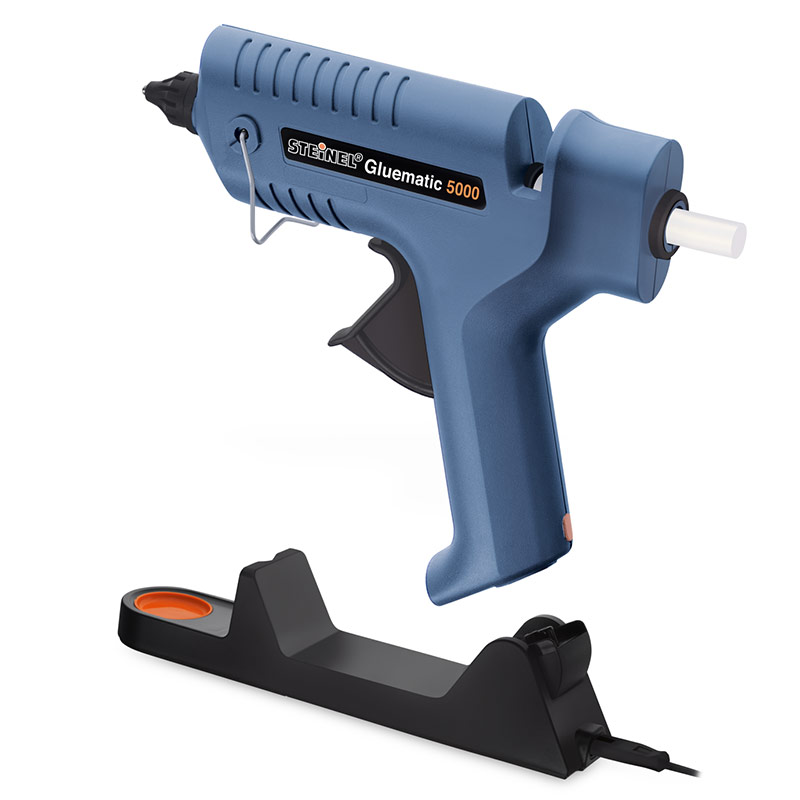
Diameter and length of glue stick
Standard and semi-professional devices are most often designed for rods with a diameter of 7 and 11 mm.At the same time, manufacturers take into account possible errors and do not indicate the exact value in the characteristics of the device but its range - usually it is 7-8 and 11-12 mm.
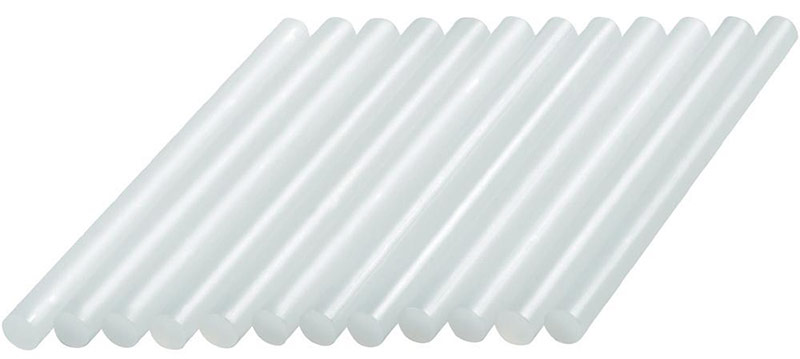
Professional devices that are used in industrial production and are designed to give out a large amount of glue per unit of time, use larger diameter rods - up to 45 millimeters.
Some manufacturers produce oval-shaped rods and pistols for them - they have no differences in work, but choosing such a device it is advisable to clarify the possibility of acquiring consumables for them in the future.
The length of the rods can vary from 4 to 20 centimeters, but since cooling and warming are not critical for them, it is allowed to charge a long rod and use the thermal gun with interruptions until it is used up.
The rods also vary in color - blue, yellow, black or with sparkles. In addition to decorative applications, manufacturers can thus mark rods for various tasks. For example, rods for gluing glass are often painted yellow, and black for sealing joints.

It should be borne in mind that there are no uniform standards yet, therefore, each manufacturer is free to paint the rods as he sees fit. Therefore, you should not focus only on color and when buying, be sure to ask the seller about the purpose of the glue or ask for instructions.
As a result, how to choose the right glue gun and for which rods depends entirely on the purpose of its acquisition. For small crafts, a device designed for rods of 7-8 millimeters is quite enough, and if more productive work is planned, then 11-12. If frequent replacement of the rod is not expected (for example, to work with materials designed for a different temperature), then their length can be ignored.
Feed mechanism
Here, the main difference is the presence / absence of the trigger or the design of the latter. If the trigger does not have a trigger, then the rod will have to be fed into the heating chamber manually - this is an inconvenient and low-practical system, which is practically not used, but is still found in budget models. This design has only one advantage - there is no risk of breaking the pulling mechanism. This is a drawback, because when manually pushing the rod into the heating chamber, the risk of damaging the guide sleeve increases, which in most cases leads to damage to the entire device.
If the trigger is present, then it can be rotary or lingering - in the first case it resembles a sector of a circle, and in the second it is a rectangle. Using a swivel is much easier - you need to put less effort into it, and the dosage of glue is more accurate.
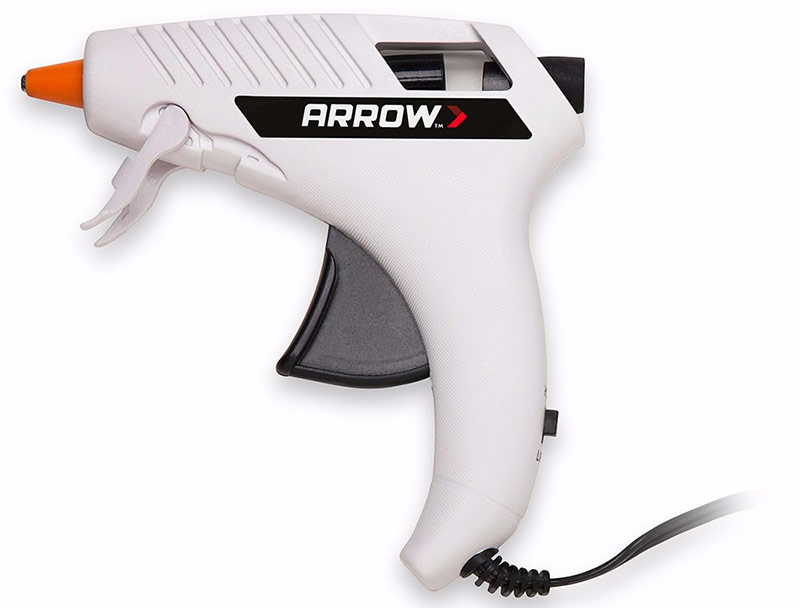
Swivel trigger.
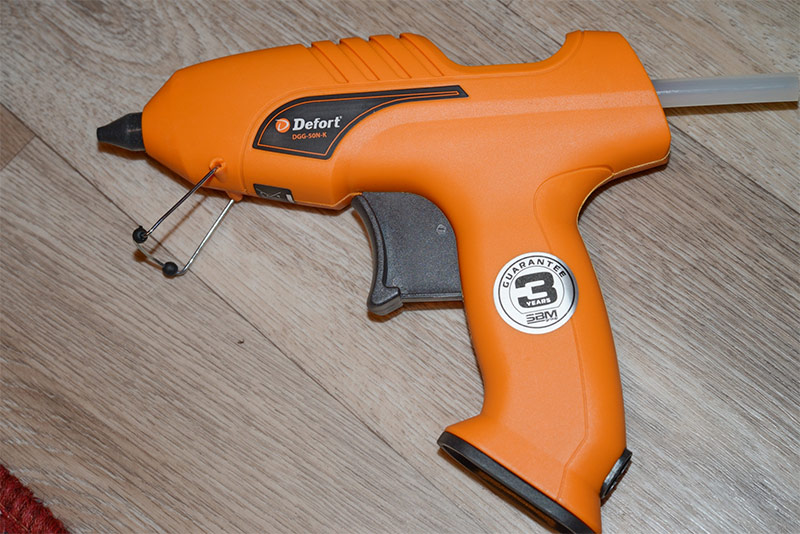
Pull trigger.
The presence of nozzles nozzles
Here the choice is very simple - removable nozzles are always better than one built-in, and the larger the number, the more functional the tool will be.
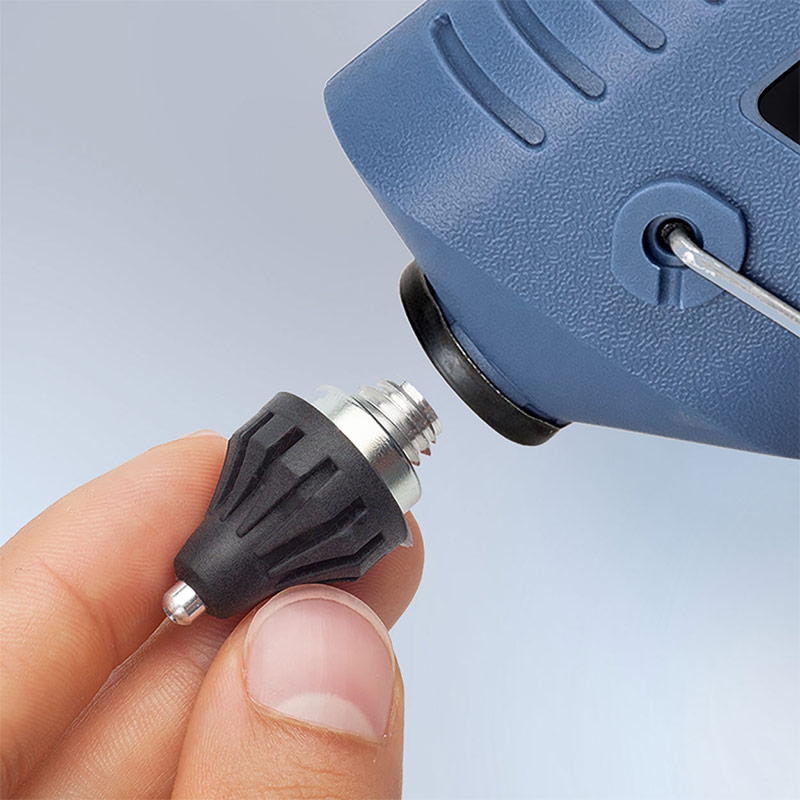
At the same time, depending on the proposed scope of work, it does not hurt to pay attention to the shape of the nozzles - it is not always round - periodically come across flat nozzles that can spread glue in the form of a track.
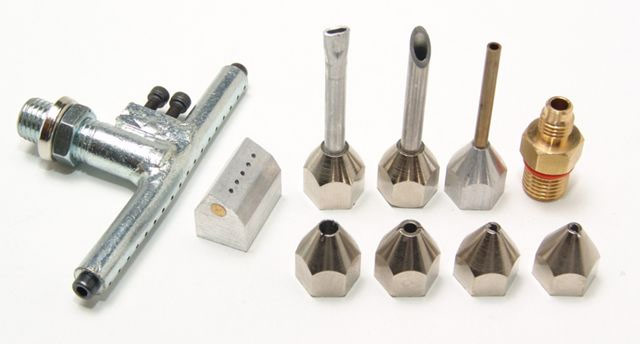
It is also worth inspecting the quality of the thread so that the nozzles can be twisted / twisted without interference, as well as on which key the slots are sharpened under. Sometimes there is little space left for them and it is very inconvenient to unscrew them with a standard wrench, and using pliers can damage the protective coating.
Additional options for comfortable work
If the technical characteristics of the device determine the quality of its operation, then there are a number of additional options that directly affect the comfort of using the device. It will be useful to take a closer look at them, especially if the thermal gun is purchased for regular use.
The presence of a temperature controller. Determines the versatility of a device that can be used to work with a large number of materials.
Electronic automatic temperature control. The prerequisites for the introduction of this function was the negative experience of users of conventional devices, which noticed that if you did not disconnect them from the network during breaks, then thermo guns are much more likely to break due to overheating. Now the electronics switches the device between three operating modes: warm-up, operating temperature, and reduced standby power consumption.
Readiness indication. When the heating chamber is gaining the calculated temperature, the LED on the thermogun case lights up. The function extends the life of the device as the user does not try to squeeze out the not yet melted glue from the gun, exerting excessive force on the feeding mechanism.
Backlight. One of those options that you don’t know exactly when will it come in handy, but sooner or later its presence really helps.
Viewing window. Present in almost all models - budget and expensive. It is useful in those cases when it is necessary to replace a long rod or to check how it goes into a short fuser so as not to damage the coupling.
Stand. Since the thermal gun must be in the standby mode with the nozzle down, the presence of a reclining stand is considered mandatory. Another thing is that not in all models this part provides sufficient stability of the device, so it is advisable to pay attention to it when buying.
Equipment. It all depends on the manufacturer, who can offer with the device a branded case, a set of rods for various needs, as well as a heat-resistant mat, from which it is easiest to clean the glue dripping from the nozzle.
Since the thermogun is a fairly simple device, in fact, it is not much more complicated than a soldering iron, even if it is used correctly, even a budget model can last a very long time, even if this device is not a well-known brand. However, even branded devices with protective electronics and other “goodies” are quite inexpensive - you just have to choose which glue gun will be better for your needs.

